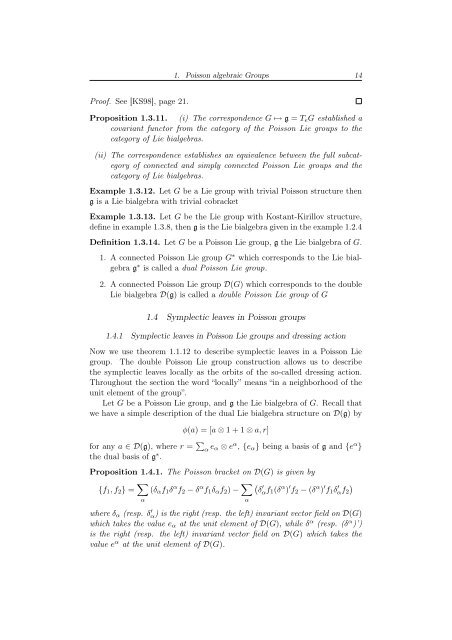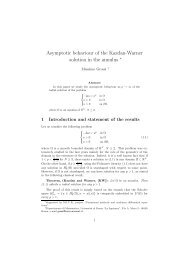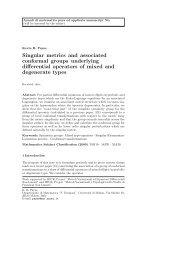Degree of Parabolic Quantum Groups - Dipartimento di Matematica ...
Degree of Parabolic Quantum Groups - Dipartimento di Matematica ...
Degree of Parabolic Quantum Groups - Dipartimento di Matematica ...
Create successful ePaper yourself
Turn your PDF publications into a flip-book with our unique Google optimized e-Paper software.
Pro<strong>of</strong>. See [KS98], page 21.<br />
1. Poisson algebraic <strong>Groups</strong> 14<br />
Proposition 1.3.11. (i) The correspondence G ↦→ g = TeG established a<br />
covariant functor from the category <strong>of</strong> the Poisson Lie groups to the<br />
category <strong>of</strong> Lie bialgebras.<br />
(ii) The correspondence establishes an equivalence between the full subcategory<br />
<strong>of</strong> connected and simply connected Poisson Lie groups and the<br />
category <strong>of</strong> Lie bialgebras.<br />
Example 1.3.12. Let G be a Lie group with trivial Poisson structure then<br />
g is a Lie bialgebra with trivial cobracket<br />
Example 1.3.13. Let G be the Lie group with Kostant-Kirillov structure,<br />
define in example 1.3.8, then g is the Lie bialgebra given in the example 1.2.4<br />
Definition 1.3.14. Let G be a Poisson Lie group, g the Lie bialgebra <strong>of</strong> G.<br />
1. A connected Poisson Lie group G ∗ which corresponds to the Lie bialgebra<br />
g ∗ is called a dual Poisson Lie group.<br />
2. A connected Poisson Lie group D(G) which corresponds to the double<br />
Lie bialgebra D(g) is called a double Poisson Lie group <strong>of</strong> G<br />
1.4 Symplectic leaves in Poisson groups<br />
1.4.1 Symplectic leaves in Poisson Lie groups and dressing action<br />
Now we use theorem 1.1.12 to describe symplectic leaves in a Poisson Lie<br />
group. The double Poisson Lie group construction allows us to describe<br />
the symplectic leaves locally as the orbits <strong>of</strong> the so-called dressing action.<br />
Throughout the section the word “locally” means “in a neighborhood <strong>of</strong> the<br />
unit element <strong>of</strong> the group”.<br />
Let G be a Poisson Lie group, and g the Lie bialgebra <strong>of</strong> G. Recall that<br />
we have a simple description <strong>of</strong> the dual Lie bialgebra structure on D(g) by<br />
φ(a) = [a ⊗ 1 + 1 ⊗ a, r]<br />
for any a ∈ D(g), where r = <br />
α eα ⊗ e α , {eα} being a basis <strong>of</strong> g and {e α }<br />
the dual basis <strong>of</strong> g ∗ .<br />
Proposition 1.4.1. The Poisson bracket on D(G) is given by<br />
{f1, f2} = <br />
(δαf1δ α f2 − δ α f1δαf2) − <br />
α<br />
α<br />
δ ′ αf1(δ α ) ′ f2 − (δ α ) ′ f1δ ′ αf2<br />
where δα (resp. δ ′ α) is the right (resp. the left) invariant vector field on D(G)<br />
which takes the value eα at the unit element <strong>of</strong> D(G), while δ α (resp. (δ α )’)<br />
is the right (resp. the left) invariant vector field on D(G) which takes the<br />
value e α at the unit element <strong>of</strong> D(G).








